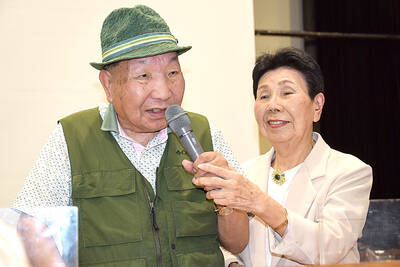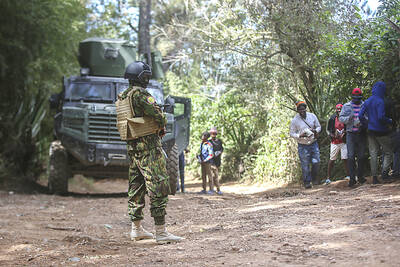British scientists have unveiled plans to create a digital library of all life on Earth. They say that the Digital Automated Identification System (Daisy), which harnesses the latest advances in artificial intelligence and computer vision, will have an enormous impact on research into biodiversity and evolution.
Daisy will also give amateur naturalists unprecedented access to the world's taxonomic expertise: Send Daisy a camera-phone picture of a plant or animal and, within seconds, you will get detailed information about what you are looking at.
At the Natural History Museum in London, Norman MacLeod, keeper of palaeontology, has spent several years developing the new technology.

PHOTO: AP
He said that Daisy will make the identification of plants and animals more objective and directly comparable. "Right now, taxonomy is as much of an art form as it is a science,'' MacLeod said. He would present his vision for Daisy to an international meeting of taxonomists at the museum yesterday.
Taxonomists normally identify specimens through a painstaking process in which the features of an unknown plant or animal are compared with identified specimens in the museum's collections. If it is sufficiently different, the unknown specimen is confirmed as a new species.
However, there is plenty of room for error -- the museum's collection might be incomplete or the person making the identification could make a mistake.
If scientists did not have to make routine identifications and teach others how to do it, MacLeod argues, they could get on with the business of learning more about biodiversity and evolution.
"Say you saw a butterfly, you might take a digital image of it, connect up to the World Wide Web and access a Daisy Internet portal," MacLeod said. "The portal would accept the picture and farm it out to the servers in individual institutions, such as the Natural History Museum."
Using pattern-recognition software, Daisy would try to match the picture with images in its archives. "The portal would route the answer back as a Web page that had the confidence level of the identification and the institution that made the identification,'' MacLeod said.
Daisy can also identify sounds and scans of DNA barcodes.
"New developments in artificial intelligence and computer algorithms have taken neural nets to where they act more like human intelligence," he said. "When we see something new, we don't have to re-compute our understanding of everything else we've ever seen, we just add it to the mix. That's pretty much what we're doing with Daisy."
"Now there's a tool that we can use to justify making the investment in getting these collections of images together and building the software structures that are necessary to make the neural net able to access the images, then there's a reason to do it," he said.
There is also a role for amateur naturalists in improving the library. "One of the neat things about Daisy is that, if you submit an image and it's identified with a high level of certainty, that can then be added to the library of images, which makes Daisy more powerful," MacLeod said.
"That information can keep growing," he said.
"The more people that use [the system], the better it gets," he said.
He said that the first images and sounds have already been used to test that everything works. But filling Daisy with data from all the museums will take several years. The Natural History Museum has 70 million specimens that would need to be entered into the database.
Daisy is part of a series of projects set up by the museum to identify and catalogue life on Earth.
In February, the museum announced plans to record the genetic fingerprints for the species, to begin the process of providing a kind of biometric identity card for millions of species by 2010.

DEATH CONSTANTLY LOOMING: Decades of detention took a major toll on Iwao Hakamada’s mental health, his lawyers describing him as ‘living in a world of fantasy’ A Japanese man wrongly convicted of murder who was the world’s longest-serving death row inmate has been awarded US$1.44 million in compensation, an official said yesterday. The payout represents ¥12,500 (US$83) for each day of the more than four decades that Iwao Hakamada spent in detention, most of it on death row when each day could have been his last. It is a record for compensation of this kind, Japanese media said. The former boxer, now 89, was exonerated last year of a 1966 quadruple murder after a tireless campaign by his sister and others. The case sparked scrutiny of the justice system in

DITCH TACTICS: Kenyan officers were on their way to rescue Haitian police stuck in a ditch suspected to have been deliberately dug by Haitian gang members A Kenyan policeman deployed in Haiti has gone missing after violent gangs attacked a group of officers on a rescue mission, a UN-backed multinational security mission said in a statement yesterday. The Kenyan officers on Tuesday were on their way to rescue Haitian police stuck in a ditch “suspected to have been deliberately dug by gangs,” the statement said, adding that “specialized teams have been deployed” to search for the missing officer. Local media outlets in Haiti reported that the officer had been killed and videos of a lifeless man clothed in Kenyan uniform were shared on social media. Gang violence has left

‘HUMAN NEGLIGENCE’: The fire is believed to have been caused by someone who was visiting an ancestral grave and accidentally started the blaze, the acting president said Deadly wildfires in South Korea worsened overnight, officials said yesterday, as dry, windy weather hampered efforts to contain one of the nation’s worst-ever fire outbreaks. More than a dozen different blazes broke out over the weekend, with Acting South Korean Interior and Safety Minister Ko Ki-dong reporting thousands of hectares burned and four people killed. “The wildfires have so far affected about 14,694 hectares, with damage continuing to grow,” Ko said. The extent of damage would make the fires collectively the third-largest in South Korea’s history. The largest was an April 2000 blaze that scorched 23,913 hectares across the east coast. More than 3,000

‘INCREDIBLY TROUBLESOME’: Hours after a judge questioned the legality of invoking a wartime power to deport immigrants, the president denied signing the proclamation The US on Friday said it was terminating the legal status of hundreds of thousands of immigrants, giving them weeks to leave the country. US President Donald Trump has pledged to carry out the largest deportation campaign in US history and curb immigration, mainly from Latin American nations. The order affects about 532,000 Cubans, Haitians, Nicaraguans and Venezuelans who came to the US under a scheme launched in October 2022 by Trump’s predecessor, Joe Biden, and expanded in January the following year. They would lose their legal protection 30 days after the US Department of Homeland Security’s order is published in the Federal